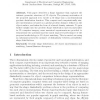Free Online Productivity Tools
i2Speak
i2Symbol
i2OCR
iTex2Img
iWeb2Print
iWeb2Shot
i2Type
iPdf2Split
iPdf2Merge
i2Bopomofo
i2Arabic
i2Style
i2Image
i2PDF
iLatex2Rtf
Sci2ools
DGCI
2003
Springer
2003
Springer
Geodesic Object Representation and Recognition
This paper describes a shape signature that captures the intrinsic geometric structure of 3D objects. The primary motivation of the proposed approach is to encode a 3D shape into a one-dimensional geodesic distribution function. This compact and computationally simple representation is based on a global geodesic distance defined on the object surface, and takes the form of a kernel density estimate. To gain further insight into the geodesic shape distribution and its practicality in 3D computer imagery, some numerical experiments are provided to demonstrate the potential and the much improved performance of the proposed methodology in 3D object matching. This is carried out using an information-theoretic measure of dissimilarity between probabilistic shape distributions.
| Added | 06 Jul 2010 |
| Updated | 06 Jul 2010 |
| Type | Conference |
| Year | 2003 |
| Where | DGCI |
| Authors | A. Ben Hamza, Hamid Krim |
Comments (0)

